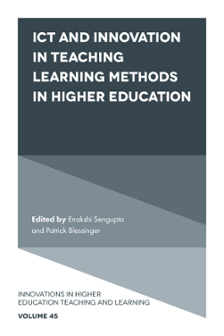
Subject Index
ICT and Innovation in Teaching Learning Methods in Higher Education
ISBN: 978-1-80043-265-9, eISBN: 978-1-80043-264-2
ISSN: 2055-3641
Publication date: 2 August 2022
Citation
(2022), "Subject Index", Sengupta, E. and Blessinger, P. (Ed.) ICT and Innovation in Teaching Learning Methods in Higher Education (Innovations in Higher Education Teaching and Learning, Vol. 45), Emerald Publishing Limited, Leeds, pp. 197-206. https://doi.org/10.1108/S2055-364120220000045013
Publisher
:Emerald Publishing Limited
Copyright © 2022 Emerald Publishing Limited
INDEX
- Prelims
- Part I: Integrative Learning
- Chapter 1: Introduction to ICT and Innovation in Teaching–Learning Methods in Higher Education
- Chapter 2: Teaching Through Collaborative Problem Solving to Make Teaching More Interactive, Student-based and Future-proof. A Teacher–Researcher Collaboration in Medicine Education
- Chapter 3: Innovative Teaching and Learning Methods at the University of Mauritius
- Chapter 4: Implementing an Innovative Curriculum Across a College
- Chapter 5: Implementing Affective Learning Outcomes Through a Meaning-centered Curriculum
- Chapter 6: Launching into Life after College
- Chapter 7: Fostering Creativity through the Integration of Classroom Technologies: A Digital Storyboarding Case Study Example
- Part II: Group-based Learning
- Chapter 8: Group-based Learning: An Innovative Practice for Engaged Learning in an Online Environment
- Chapter 9: Using Cloud-based Collaborative Office Productivity Tools (Google Workspace) to Engage Students in Their Learning and Prepare Them for the Workplace
- About the Authors
- Name Index
- Subject Index